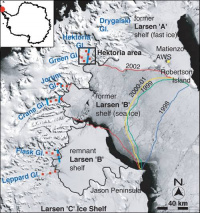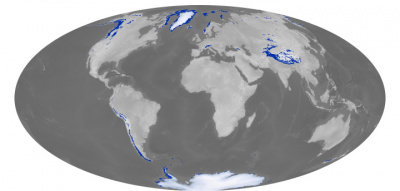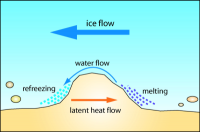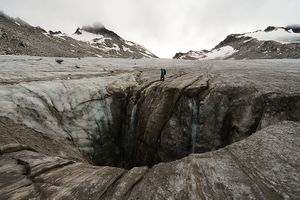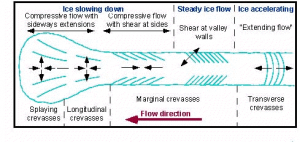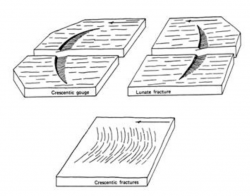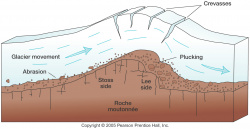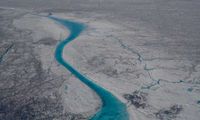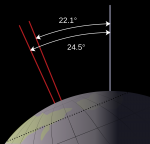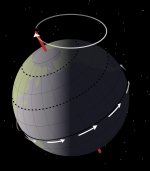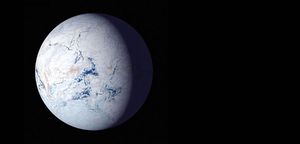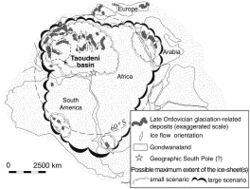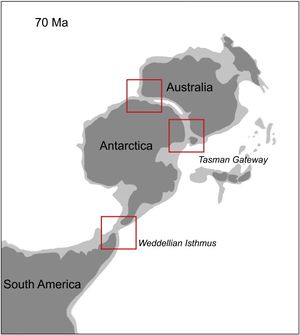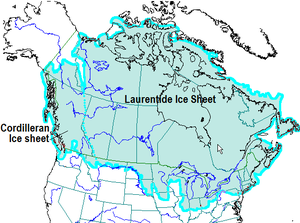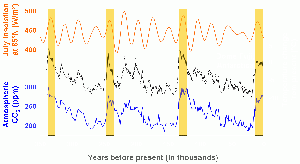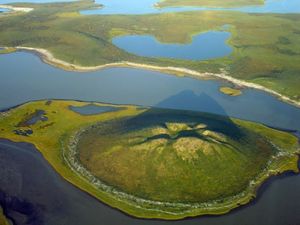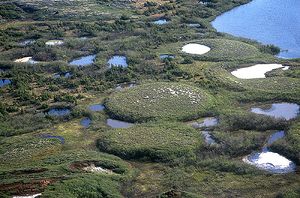Dynamic Planet/Glaciers
| Dynamic Planet/Glaciers | ||||||
|---|---|---|---|---|---|---|
| Type | Earth Science | |||||
| Category | Study | |||||
| Event Information | ||||||
| Latest Appearance | 2019 | |||||
| Forum Threads | ||||||
| ||||||
| Question Marathon Threads | ||||||
| ||||||
- This article is about the topic of Dynamic Planet for the 2019 season. For information about the event in general, see Dynamic Planet Topics.
Glaciers were the topic of Dynamic Planet for the 2019 season, replaced by Oceanography for the 2020 season. They were previously the event's topic during the 2013 and 2014 seasons.
The current version of the GMOA Notes are not suitable for this Dynamic Planet topic. There is a small section under Sedimentation and Sedimentary Rocks which covers glaciers but is very limited in scope and largely insufficient.
Introduction to Glaciers
Glaciers are large masses of snow and ice that have accumulated over years of snowfall and have flowed at some point in their lifespan. Glacier thickness can range from as little as a few dozen meters to well over 2 kilometers. They form when unmelted snow accumulates and compresses into dense, glacial ice.
All glaciers originate on land but can flow into the sea. Glaciers that extend into the ocean should not be confused with sea ice, which is formed from seawater freezing rather than snow compressing.
Glaciers are immense bodies of ice, often several gigatons in mass. As such, they leave behind a very unique landscape, with dozens of types of landforms.
Notable Glaciers
Tests for this event generally do not ask detailed questions about specific glaciers as it is primarily focused on conceptual understanding and analysis of data. However, knowledge of glacial history, including recent events involving glaciers, is within the realm of possibility. This list is by no means comprehensive and only contains basic and important information for each listed glacier.
Hubbard Glacier: Hubbard Glacier is a tidewater valley glacier located in Alaska and Canada and the largest glacier in North America. In the past, it has created and released several glacial lakes, creating disastrous floods, including the second-largest glacial lake outburst flood (GLOF) ever recorded. It routinely calves off giant chunks of ice into Disenchantment Bay near the base of the Alaskan Panhandle.
Lambert Glacier: Lambert Glacier is an outlet glacier on Antarctica and is the largest glacier in the world excluding ice fields, ice caps, and ice sheets. It drains approximately 8% of the Antarctic Ice Sheet by volume.
Siachen Glacier: Siachen Glacier is a valley glacier located in the eastern Karakoram range between India and Pakistan. The glacier is part of the ongoing Indian-Pakistani conflict in Kashmir. At 76 kilometers long, it is the second-longest non-polar glacier in the world. The whole Himalayan region, including bordering ranges, is sometimes called the "Third Pole" due to its extreme temperatures being comparable to those of the Arctic and Antarctic.
Vatnajokull: Vatnajokull is an ice cap in Iceland. It is the largest glacier in Iceland, covering more than 9% of the land area of the nation, and second-largest by area in Europe. It is known particularly for its jökulhlaups, or glacial outburst floods, triggered by the volcanic activity of the island.
Larsen B: Larsen B was an ice shelf attached to the Antarctic Peninsula. From around 31 January to 7 March 2002, approximately 3,250 square kilometers of Larsen B's floating ice broke off from the continent. After the collapse of 2002, there was still a sizable portion remaining in the south which has since disappeared. Prior to its collapse, Larsen B had been stable for thousands of years, at least since the last ice age. During the decades leading up to its collapse, warm water currents were eating away at the underside of the shelf. It was shown to be unstable since at least 1995, with smaller, but still alarmingly large chunks being calved off from the main ice shelf, most notably one in 1998. The collapse in 2002 was further caused by ponds of meltwater which had formed during the 24-hour exposure to the sun during the Antarctic summer. The water flowed into cracks in the ice, wedged it apart, and disintegrated the ice shelf.
Patagonian Ice Fields: The North and South Patagonian Ice Fields, technically separate ice fields, are among the largest in the world and cover much of the Andes Mountains in Argentina and Chile. The South Patagonian is the larger of the two. During the Last Glacial Period, the two were joined together as one and covered almost all of southern Chile. Much like the other glaciers listed here, they have become an important site for research on climate change and global warming.
Greenland Ice Sheet: The Greenland Ice Sheet covers about 80% of the surface of Greenland and is second in size only to the Antarctic Ice Sheet. It is surrounded by several small glaciers and ice caps. With an average thickness of 2.1 km, a complete melt of the Greenland Ice Sheet would cause 7-8 meters of sea-level rise.
Antarctic Ice Sheets: The East and West Antarctic Ice Sheets comprise the vast majority of ice in Antarctica and the majority of ice in the world. They both have dozens of outlet glaciers on their fringes and are separated by the Transantarctic Mountains. The East Antarctic Ice Sheet is by far the larger of the two, having 9 times the volume of the West Antarctic Ice Sheet and containing about 4/5ths of all the world's ice. The East Antarctic Ice Sheet is about 2.2 km thick on average, while the West is only 1.3 km thick. Most of the West Antarctic Ice Sheet actually sits below sea level, which has left it more susceptible to melting and collapse. The ice shelves that buttress it are also at risk. The collapse of the West Antarctic Ice Sheet would cause a rise in sea level of 6 meters; the collapse of the East Antarctic Ice Sheet would cause a rise of over 55 meters.
Laurentide Ice Sheet: The Laurentide Ice Sheet was a historical ice sheet that covered most of North America during the Pleistocene glaciation. It was 4-5 kilometers thick in many areas but was perforated by many nunataks over hills and mountains near its fringes. It greatly shaped the appearance of modern-day North America, leaving behind moraines, eskers, and till everywhere. The Great Lakes were deepened under the forces of the Laurentide Ice Sheet, reaching their present-day form. It mostly disappeared at the end of the Pleistocene glaciation 11.7 Ka ago, but left numerous large ice caps and glaciers in its former ranges, mostly in Canada.
Distribution of Glaciers
Glaciers can form anywhere that the average annual temperature is low enough for snow to last all year round. These locations are typically in high latitudes or at high elevations. Glaciers are found in/around all seven continents.* The total area that they cover is approximately 15,000,000 square kilometers, around 10% of the world's land area.
* Continental Australia does not have any glaciers, but several islands considered part of Oceania, namely New Zealand, do have some.
| Antarctica | 11,965,000 |
| Greenland | 1,784,000 |
| Canada | 200,000 |
| Central Asia | 109,000 |
| Russia | 82,000 |
| United States (with Alaska) | 75,000 |
| China & Tibet | 33,000 |
| South America | 25,000 |
| Iceland | 11,260 |
| Scandinavia | 2,909 |
| The Alps | 2,900 |
| New Zealand | 1,159 |
| Mexico | 11 |
| Indonesia | 7.5 |
| Africa | 6 |
| New Guinea | 3 |
- Data taken from various sources, primarily the following site: http://nsidc.org/cryosphere/glaciers/questions/located.html
Important Note: Please take these numbers with a considerable grain of salt. The numbers presented here, especially the smaller ones, have undergone several dramatic changes in the past few decades, sometimes even within a single year. As such, some information may not properly reflect current data. Sources may also give conflicting reports.
Formation
Glaciers form when snow and ice last through the summer and accumulate over time. As snow begins to build up, it compresses the snow below it to form ice.
First-year glacial snow is known as névé. It is partially melted & re-frozen, slightly compacted, and granular. Accumulated snow that has survived one melt season is known as firn. Firn is denser and more re-frozen than névé and is very stiff. As more and more layers of snow accumulate, lower, older snow begins to have its air bubbles squeezed out. Once this ice lasts through summer months and achieves the critical mass that allows it to flow, it is considered a glacier.
- Note: The term "nivation" describes the above process but is considered too vague. Its use is discouraged.
Under the immense pressures of several meters of snow, ice is formed, which is denser than "normal" ice due to the lack of air bubbles. The lack of air bubbles also why glaciers and icebergs are bluish. The difference in density between glacier ice and regular ice is very minimal—only a few grams per cubic meter.
There are a wide variety of conditions that affect the formation and preservation of glaciers. While these all have some influence on the formation of glaciers, as well as their advance and retreat, certain parameters have much larger or smaller impacts than others. Precipitation, temperature, and insolation have the greatest impact.
| Parameter | Condition Favoring Development | Reason |
|---|---|---|
| Precipitation | High | Increases Accumulation |
| Temperature | Low | Reduces Ablation |
| Insolation (Sun Exposure) | Low | Reduces Ablation |
| Wind | Low | Reduces Snow Removal |
| Humidity | High | Increases Precipitation, Reduces Ablation by Sublimation |
| Elevation | High | Reduces Temperature, Increases Precipitation |
| Gradient (Slope) | Low (Shallow) | Slower flow from Accumulation to Ablation zones |
| Latitude | High | Lower Temperature & Insolation |
| Continentality | Maritime (Near Water) | Increased Humidity |
| Aspect (Direction it faces) | Poleward | Shade reduces temperature |
| Accumulation Character | Avalanche-prone area | Increases accumulation |
| Termination | Not water or cliffs | Reduces large-scale losses from calving & ice avalanches |
| Geothermal Heat | Low | Reduces Ablation & basal melting |
Additionally, debris cover can play a role in the preservation of glaciers. In small amounts, such as windblown dust and small rocks, the debris will absorb more heat due to their darker color. This leads to additional melting at the surface and often can form cryoconite holes. However, if the glacier becomes fully encased in debris (from a landslide or similar), the opposite effect takes place. The debris will create a protective shield, prevent sunlight from melting the glacier.
Movement
Glaciers move due to gravity. While other factors affect the rate and specific ways in which glaciers flow, the driving force can always be attributed to gravity. Unsurprisingly, the steeper the incline, the faster it will flow. Glaciers generally cannot flow independently on level ground or over uphill terrain until they are over 60m thick.
The advance and recession of a glacier should not be confused with its flow. A glacier never flows backward up the mountain*, but it can have a net loss of ice at its terminus to make it appear to move higher up the mountain. Advance and recession only concern mass balance, not motion.
The actual method in which a glacier flows is dependent on several factors. There are three main ways a glacier can flow: Basal Sliding, Internal Deformation, and Bed Deformation. Most glaciers can rely on two or even all three methods to move. This does not mean that all three methods occur in the same location on the glacier. Rather, environmental differences along the glacier, such as varying temperature or meltwater, create different flow conditions along its length.
* A glacier can flow uphill to get over obstacles, but never up towards its own head.
Basal Sliding
This process involves the movement of the base of the glacier across the bedrock upon which it lies, usually incorporating meltwater. When comparing glaciers that undergo basal sliding, thinner, steeper glaciers are most active. There are 3 ways in which basal sliding is accomplished.
- Basal Slip occurs when a thin layer of water between the ice and underlying rock lubricates the glacier, allowing for faster flow. This meltwater can come from a variety of sources, including pressure-melting, percolation, and water channels such as moulins. Basal slip is generally more applicable to smoother bedrock surfaces but still constitutes the majority of basal sliding. Additionally, if enough meltwater is present, basal slip can allow for a surge to occur.
- Enhanced Basal Creep takes place when the ice encounters a large obstacle. The large increase in pressure causes the ice to deform plastically around the obstacle.
- Regelation Flow happens when ice encounters a small bedrock obstacle. Rather than deforming around it, the ice melts under the pressure and refreezes on the other side. This only happens if the object is small enough to allow the latent heat on the lee side (downhill, refreezing) to be quickly conducted to the stoss side (uphill, melting) to assist further melting.
Internal Deformation
Also known as Creep, Internal Flow, Plastic Flow, and Plastic Deformation, this process involves ice crystals slowly sliding across each other within the glacier. Ice can deform because it behaves plastically with extreme pressures, which are standard conditions within glaciers. Internal deformation occurs in all types of glaciers and is not reliant on meltwater.
Additionally, glaciers flow faster near their centers than their periphery due to internal deformation. Ice can slide much more readily against other ice than the rough, rocky bed, leading to a 'sagging' shape that can sometimes be seen in the ice.
Bed Deformation
(Sometimes Subglacial Deformation) As its name suggests, Bed Deformation involves the shifting of softer sediments to allow the glacier to move downhill. Subglacial till is composed of unsorted sediments with a wide range of sizes, from boulders to clay. Finer sediments, such as clay and sand, deform readily when shear stress is applied and also have high power-water pressure (pressure of groundwater between particles). Much like basal sliding, bed deformation depends on meltwater at the base. Basal sliding is more efficient if water remains directly under the surface of the ice, whereas bed deformation is more prevalent where the sediment becomes saturated with water, reducing its strength.
Thermal Regime
Due to the importance of meltwater in two of the three methods of glacier flow, the thermal regime of a glacier cannot be ignored. Simply put, the temperature of a glacier, more specifically its base, determines its thermal regime. Thermal Regime is generally considered another method of classifying glaciers in addition to morphological characteristics.
Cold-Based (Polar): These glaciers are frozen effectively year-round, excluding seasonal melting near the surface. Most importantly, the base of the ice is frozen. These are generally found at higher latitudes and have lower seasonal variations in temperatures. There is very minimal to no meltwater. They move exclusively via internal deformation without any basal slip or bed deformation. The ice is generally frozen to the rock.
Warm-Based (Temperate): Also known as Wet-Based, glaciers of this thermal regime are characterized as being warm enough to have meltwater. They are generally at or very close to their melting point during the year throughout the entire thickness of the glacier. They are generally found at lower latitudes. The movement of these glaciers is largely through basal sliding (specifically basal slip). Meltwater plays a substantial role in the process, mainly coming from surface melt that is channeled to the bottom through moulins, tunnels, crevasses, and more. If the basal ice melts, either through temperature or pressure-melting, additional basal slip can occur. During the winter months, the glacier often refreezes to the bedrock, slowing the movement periodically. The meltwater of warm-based glaciers can also lead to an increase in plucking which will cause more sediment transport.
Polythermal (Subpolar): Polythermal glaciers are those which have components of both warm- and cold-based glaciers, which vary depending on the location. Realistically, most valley glaciers are polythermal, containing both elements of warm- and cold-based glaciers, depending on the location on the glacier. They can range from mostly warm-based to mostly cold-based.
Other Factors that Control Movement
Bedrock conditions are frequently the largest force acting against the flow of a glacier. Friction with rougher surfaces will always act to slow the motion of a glacier.
Terminal conditions also play a major role in glacier movement. Debris at the end of a glacier, such as a terminal moraine, provide an extra buffer to glacial movement. Ice shelf buttressing operates on similar principles. Ice shelf buttressing occurs when an ice shelf prevents an outlet glacier from advancing any further into the sea, slowing or stopping its flow. Ice shelf buttressing is critical to the stability of the Antarctic and Greenland ice sheets. Without the presence of ice shelves, outlet glaciers would drain these ice sheets without restrictions, causing a severe change in their mass balances. Tidewater glaciers, which empty into water without ice shelf buttressing, generally have higher rates of flow and calving.
Mass Balance
A glacier's mass balance is defined as the difference between accumulation and ablation. Accumulation is the addition of snow or ice onto the glacier, while ablation (also called wastage or wasting) is the depletion of ice from the glacier, through processes such as sublimation and evaporation. A glacier will advance when there is a net positive gain in ice, particularly at the terminus, making it grow further downslope. A glacier will retreat when the opposite occurs; it will melt away, leaving the terminus higher up the mountain. The visual appearance of advance and retreat should not be confused with the flow of a glacier, which is always away from the glacier head.
Glacier Parts
Glaciers are very large bodies, and, despite their slow movements, contain dynamic areas which create various features, many of which are common to all glaciers. Some of these are physical phenomena, while others are simply classifications based upon the conditions in that section.
Zones & Sections
Head: The upper end/beginning of a glacier. These are only characteristic of mountain glaciers, as ice fields, ice caps, and ice sheets don't have a designated "beginning".
Foot/Terminus: The downhill end of a glacier. This term applies more to mountain and outlet glaciers, as ice fields, ice caps, and ice sheets exclusively drain into outlet glaciers or terminate as ice shelves.
Zone of Ablation: (Zone of Wastage) The area of a glacier where annual melting is greater than accumulation (negative mass balance) and the glacier becomes smaller. This is always on the lower "half" of the glacier and includes the terminus. The ablation zone can grow and shrink depending on the season, becoming its largest during the summer months.
Zone of Accumulation: The area of a glacier where annual accumulation is greater than melting (positive mass balance) and the glacier becomes larger. This is always on the upper "half" of the glacier and includes the head. The accumulation zone can grow and shrink depending on the season, becoming its largest during the winter months.
Snow/Equilibrium/Firn Line This is the line that separates the accumulation and ablation zones. This, like the two zones, varies in location depending on the time of year, going higher up the glacier during warmer months.
Moulins
Moulins (French: Mill), also called Glacier Mills, are narrow, near-vertical tubes within a glacier which start at the surface. They are generally found in a flat section within transverse crevasses. They vary greatly in depth but are generally no more than 10 meters wide. They carry meltwater down to the base, which can lubricate the glacier as it slides along. They are generally more characteristic of mountain glaciers but are not exclusive to them.
Sometimes, these water currents plunge into the bedrock below, creating a hollowed-out region which goes by many different names, including giant's kettle, giant's cauldron, pothole, glacial pothole, moulin pothole, and glacier mill cavity. This feature is created when debris from the falling water erodes the bedrock beneath it. This often involves a swirling motion, creating the roughly cylindrical shape of the pothole. The debris deposited is often smoothed out through the constant erosion.
Crevasses
Crevasses are deep cracks or fractures in a glacier. They form when ice undergoes brittle deformation, splitting apart due to extreme stress in a (relatively) short period of time. The presence of water in a crevasse can greatly affect the dynamics of a glacier. If a crevasse runs deep enough, it provides a direct connection between surface melt and the bed, providing lots of water to cause or increase basal slip. Crevasses also preserve marks of stress and strain, allowing the movements of a glacier to be deciphered.
Crevasses should not be confused with crevices, which are cracks in rocks.
Crevasse Types & Formation
Crevasses form from stresses of all types. The various types of crevasses are categorized by the stresses that create them.
- Marginal Crevasses: form near the sides (margins) of a glacier. As a glacier grinds past the stationary valley walls, the ice in the center flows faster, applying shear and tensional stress. This results in crevasses pointed upslope at around 45 degrees from horizontal.
- Longitudinal Crevasses: form parallel to the direction of flow. They form where the glacier expands in width or on the outside edge of a turn where the valley bends. When viewing from downslope, they also form a concave down shape but are generally nearly parallel to the valley walls.
- Splashing/Splay Crevasses: typically form near the terminus, where the flow is compressional. The crevasses are approximately parallel to ice flow. They are similar in appearance and orientation to longitudinal crevasses but form from compressional forces pushing ice out laterally. If a glacier spreads out wide enough at the terminus, such as in a piedmont glacier, splay crevasses will radiate outwards from a centerline.
- Splashing/Splay Crevasses should not be confused with crevasse splay, a non-glacial fluvial deposit.
- Transverse Crevasses: are the most common type of crevasse. They form in the zone of extending flow, where the stress is parallel to the direction of flow. The tension stretches the glacier until it fractures. They run side-to-side across the mountain, being nearly perpendicular to flow. They also form where the valley steepens, such as at an icefall. An ice fall, much like a waterfall, is a region of the glacier's flow where there is a sudden change in altitude. This results in heavy amounts of crevassing as the surface layers of ice are stretched more than at the base.
- Randklufts and Bergschrunds
- Randklufts and Bergschrunds are two special types of transverse crevasses. A Randkluft (German: marginal crevasse) is the gap between the headwall of a glacier (the steep back/upper wall of a cirque) and the ice downslope of it. They are formed when the ice directly in contact with the rock is melted and widened in the warmer months. They are generally found in lower-altitude glaciers. A Bergschrund, sometimes Schrund (German: mountain cleft), is a crevasse that forms between a stagnant block of ice above and a moving block of ice below. They generally are found at higher altitudes.
Crevasse Depth
The depth of a crevasse is controlled primarily by two factors: compressive pressure from the ice and expansive pressure from water. The deeper one goes into a glacier, the greater the pressure is keeping a crevasse shut. This is why crevasses typically don't grow to be more than about 3 meters deep—the internal compression from the glacier overpowers the tensile forces pulling it apart. However, the addition of water can seriously upset this balance. As with the ice, water exerts greater pressure the deeper it is, meaning the crevasse can grow much deeper than before. This can easily lead to a crevasse going deep enough to reach the base of the glacier, allowing for significant meltwater drain and an increase in basal slip.
Ogives
Also known as Forbes bands, Ogives are alternating crests and valleys in the glacier ice that appear as dark and light bands of ice. Ogives are directly linked to the seasonal motion of a glacier. The distance across one light and dark band is roughly equal to the annual movement of a glacier. Ogives form downslope of icefalls, which contain large transverse crevasses. These crevasses will, if not too far into the ablation zone, be filled with snow, usually over only a couple of seasons. This accumulation will create the visible light-dark pattern which defines ogives, with the light being snow and the dark being ice.
The darker bands lack trapped air bubbles, a result of the way glacier ice forms. The lighter bands are filled with fresher snow and air pockets and are also much less dense. They generally take on a crescent shape, being concave up when viewed from downslope. This is due to the increased rate of flow near the center of the glacier. The variations in height of the different bands of the ogvies are caused by uneven melting due to the different colors, with darker bands absorbing more solar radiation and thus melting more. Sometimes, ogives lack either the undulating surface and even more rarely, the distinct color variations. Due to the way they form, ogives are very uncommon on unconstrained ice sheets, ice caps, and ice fields.
Glacial Morphology
Glaciers are generally classified by their location and general features. The majority of classifications fall into two categories based upon constrainment by underlying topography.
Constrained
Glaciers that are constrained by underlying topography are almost always confined by mountains, leading to the nearly synonymous name of mountain glaciers. The only exception is ice fields.
Valley: Valley glaciers are a general group of glaciers that flow through the valleys between mountains. Sometimes they originate from cirque glaciers that have spilled out of their cirques and down into the valley.
Piedmont: (French: Foot of Mountain) Piedmont glaciers are valley glaciers that have flowed out beyond the edge of the mountains and into an open plain. They are characterized by a fan or mushroom shape at the foot of the mountain. The terminus is often filled with splay crevasses.
Cirque: (French: Circus or Stadium) Cirque glaciers are generally the smallest type of glacier and form in bowl-shaped depressions in mountains. They can expand beyond their original confines and become a valley glacier.
Ice Field: Ice fields are large expanses of glaciers which cover mountains up almost to their peaks, leaving nunataks poking out. This means that ice fields are still partially confined by the mountains they reside in. They can form when a large number of valley glaciers or even smaller ice fields join together.
Outlet: Outlet glaciers are a special form of valley glacier which drain ice from ice caps, ice fields, and ice sheets through narrow mountain passages. These can terminate both on land, into an ice shelf, or simply into the ocean.
Unconstrained
Unconstrained glaciers are not restricted by underlying topography, extending over vast flat areas. The nearly synonymous term continental glaciers generally refers to ice sheets and ice caps only, with the much smaller ice stream being excluded.
Ice Cap: An ice cap is a dome-shaped mass of glacier ice that spreads out in all directions. Ice caps are usually larger than ice fields but always under 50,000 sq. kilometers. The dome shape refers to the fact that accumulation, if it occurs, is generally near the center, leading to a raised area that will flatten out by internal deformation.
Ice Sheet: An ice sheet is the same as an ice cap, except it is greater than 50,000 sq. kilometers. Ice caps and ice sheets are collectively referred to as continental glaciers.
Ice Stream: Ice streams are special areas of ice caps and ice sheets with substantially increased rates of flow, upwards of 500-1000 meters per year. They are important for the mass balance of the ice caps and ice sheets and are often riddled with crevasses and shear margins from the substantial tension and shear stresses.
Other Glacier Types
There are other classifications for glaciers which do not specifically belong to the morphological categories or are simply subtypes of the previously mentioned examples.
General
Tidewater: Any glacier which terminates in water but does not extend far beyond the coast is considered a tidewater glacier. These are generally valley and outlet glaciers. They calve at very high rates, creating lots of icebergs which can be a hazard to oceangoing vessels. They generally have high flow rates due to the calving.
Ice Tongue: A valley, outlet, or ice stream which extends rapidly out into the sea.
Ice Shelf: An ice shelf is a glacier or ice sheet which as flowed out into the ocean. These are very thick and composed of glacial ice. They should not be confused with sea ice, which is thinner and made from seawater. The area where an ice shelf is connected to land is known as the grounding line. They are large and relatively permanent, but have been known to break away and disappear, as was the case with Larsen B in 2002. Ice shelves are also responsible for ice shelf buttressing, where outlet glaciers are held back by the sheer mass of the ice shelf. Ice shelf buttressing are important to controlling the mass balance of outlet glaciers and thus ice caps and ice sheets as well.
Valley
Hanging: A valley glacier which terminates at a hanging valley is a hanging glacier.
Branched-Valley: Any valley glacier which has a tributary glacier is a branched-valley glacier.
Tributary: Tributary glaciers, much like tributaries for rivers, are smaller glaciers that merge into larger ones. They are the main contributor to the formation of medial moraines.
Distributary: Distributary glaciers are the opposite of tributaries; they are smaller glaciers which have split apart from the main body.
Cirque
Niche: A niche glacier is very small glacier that occupies gullies & hollows on pole-facing slopes of a mountain which are covered by shadows. If the conditions become more favorable, it can develop into a cirque glacier.
Glacial Geology
Deposition and Erosion are the two most important processes in glacial geology. These two processes create all the features associated with glacial landscapes.
Glacial Deposition
Diamictite: Sedimentary rock composed of a range of unsorted or poorly sorted particles. Large rocks and boulders are found in a suspension of finer clay and silt particles. It is typically formed from till or moraines, when in the context of glaciers. In general, diamictite comes from a variety of sources, the most common of which is the non-glacial underwater debris flow. In marine areas subject to cyclical advance and retreat of glaciers (i.e. the coast of Antarctica), diamictite can be contrasted with diatomite, which contains components of fossilized diatom creatures. Repeating layers of diatomite and diamictite are often evidence of glaciers advancing and retreating over a certain location.
Drift: A collective term meaning all sedimentary deposits of glacial origin. Any sediment eroded, transported, and deposited by a glacier is drift.
Dropstones: Larger, irregular, non-marine sediments found embedded in layers of marine sediments. They are carried to their location in oceans or lakes by icebergs in a process known as ice rafting. When the iceberg melts sufficiently for the stone to fall off, it becomes a "marine erratic" of sorts. (Marine erratic is only an analogy, not an actual term). Dropstones are generally much larger than the surrounding sediment, as water can only carry (and deposit) very fine sediments.
Drumlins: Elongated, streamlined hills formed from glaciers acting on till and/or ground moraine. The gently sloped and tapered end points in the direction of glacier flow. They often resemble a crag & tail. Drumlins almost always form in large groups, known as drumlin fields. They are features of continental glaciation.
Erratics: (Glacial erratics) Large, misplaced boulders or rocks transported far from their source by a glacier and left behind upon retreat. Their composition can be used to determine the direction of glacial flow by matching it with potential source rocks.
Eskers: (Eskar, Eschar, Os, Osar, As, Serpent Kame) Long, winding ridges of stratified deposit, left behind by englacial or subglacial meltwater streams. They usually run parallel to the direction of flow of the glacier. They are 5 to 50 meters tall, 50 to 500 meters wide, and can vary in length from only a few dozen meters to several kilometers. They can sometimes appear similar to railway embankments. They typically form when glacial movement is slow or stagnant, and more so near the terminus, where the ice is thinner. Sometimes, they form in supraglacial areas, such as in crevasses or supraglacial channels.
Kames: An irregularly shaped hill composed of sand, gravel & till that accumulates in a depression on a retreating glacier which is deposited on land upon further retreat. They are formed only by continental glaciers.
Kame Terraces: Formed in the same way as Kames, but along the sides of glacial valleys. They visually similar to lateral moraines in some ways, but differ in their formation method. Kame terraces from from meltwater streams depositing debris along the sides of the glacer (glacio-fluvial deposits) whereas lateral moraines from till being pushed aside.
Kettles: Often found as kettle lakes, they are formed by bits of glacial ice breaking off and forming depressions in the ground, which then melt. Kames and kettles are generally found around and about each other, creating kettle-kame topography. Thus, they are also formed only by continental glaciers.
Moraine: Any ridge or mound of glacial debris that is deposited in glaciated regions. Moraines can consist of boulders, gravel, sand, and clay, among other sediments.
- Terminal moraines: deposited at the terminus (end) of the glacier, marking its furthest advance. The term End moraine refers to both terminal and recessional moraines, as they are formed in the same way.
- Recessional moraines: recessional moraines are ridges that are behind the terminal moraine—they mark other locations where the glacier had stopped in the past.
- Lateral moraines: are material that have been pushed off to the side of glaciers.
- Medial moraines: form between two glaciers when they converge.
- Ground moraine: the layer of till and other sediments underneath a glacier.
- Supraglacial moraines: accumulations of debris on top of the glacial ice.
There are several other types of moraines which have been defined. These are comparatively rare in nature and are usually not found on tests, as either their formation mechanisms are unknown or they are specific to certain regions.
Author's Note: Even the following list of rarer types of moraines is vastly incomplete. There is a considerable amount of disunity in the glaciology world and many classifications for new and different moraines are all over the place. Many of these can be found in the paper "Mineralogy and Geochemistry of the Fine and the Clay Fractions of Till in Northern Finland".
Secondary Note: On occasion, Drumlins and Flutes are lumped into the category of moraines due to their related formation processes.
- De Geer moraines: (annual, washboard, minor, corrugated, cross-valley, sublacustrine, or lift-off moraines) are narrow, parallel ridges which run across the width of the valley. The ridges are typically irregularly spaced. Their formation method is still unclear. The two main proposals are advance & retreat (similar to recessional moraines) or formation in crevasses. They are found throughout much of Canada and parts of Maine and Alaska, as well as northern Scandinavia.
- Interlobate moraines: are functionally equivalent to medial moraines but between ice caps or ice sheets (the lobes). They are much larger than medial moraines of mountain glaciers and frequently surrounded by kettles.
- Pulju moraines: are very similar to Veiki moraines but considerably smaller. They are exclusive to northern Finland.
- Rogen moraines: (ribbed) are regularly and closely spaced, forming perpendicular to the direction of ice flow. They can often be found near drumlin fields. Their formation is unclear, but their close proximity to drumlins has led to the theory that they are formed by glaciers acting on drumlins (and other features) when the glacier changes direction. All theories propose that Rogen moraines are formed directly under the ice.
- Veiki moraines: are hummocky and irregular moraines with many ponds and plateaus. They form from the irregular melting of debris-covered ice and are most common in northern Sweden, Canada, and Finland.
A list of more (useless) moraine types
... to be expanded |
Varves: Annual layers of sediment. They form in marine and lacustrine (lake) environments — in the context of glaciers, it is primarily via meltwater lakes. During the summer months, water flow is higher, leading to smaller particles (i.e. clay) remaining suspended while larger particles (i.e. sand) sink to the bottom to form layers. When meltwater flows are reduced in colder seasons, the less turbulent water will deposit the finer particles as well, forming unique bands of (typically) light bands (sand & silt) and dark bands (clay, sand, and silt). Varves can be interrupted by dropstones.
Glacial Erosion
The majority of erosional features are characteristic of alpine glaciation.
Arête: (French: Rib or Ridge) A sharp parallel ridge of rock that resists erosion, formed by two cirque glaciers coming together but not joining. The glaciers are usually flowing down opposite sides of a mountain. Unsurprisingly, these are characteristic of mountain glaciers only.
Cirque: (French: Circus or Stadium) A large bowl shaped area carved out of a mountain by a moving glacier. They are bounded by a steep cliff know as a headwall. Cirques are also called corries or cwms.
Chatter Marks: (Chatter) Small, curved fracture found in bedrock which has been passed over by a glacier. They are formed by englacial debris acting on the underlying bedrock, typically harder and more brittle rocks. They range in size from submicroscopic marks to over 50 centimeters in length. There are three different types of chatter marks: Crescentic Gouges, Crescentic Fractures, and Lunate Fractures. The features and characteristics of the variations of chatter marks are currently under review due to many conflicting sources.
Crag & Tail: A rocky hill, isolated from other peaks and hills, formed when a glacier passes over a resistant rock formation (often granite or a magmatic intrusion) surrounded by softer material. The softer material behind the block, relative to glacier flow, is sheltered, and creates a shallow, tapering tail on the leeward side of the crag. Post-glacial erosion can often remove the tail. These are found in areas glaciated by continental glaciers.
Hanging Valley: A valley cut across by a deeper valley. This term is not exclusive to glacially-created valleys, as rivers valleys (V-Shaped) can also undercut other valleys. Hanging glaciers can form as a result of this as well.
Horn: A pyramidal peak formed by three or more cirques meeting on a central. They are also called pyramidal peaks. The Matterhorn (Italy & Switzerland, Alps) is a very famous example. Horns are often examples of nunataks.
Outwash Plain: Broad, low-slope angle alluvial plain made of glacially eroded, sorted sediment (outwash) that has been transported by meltwater. While these are generally more associated with continental glaciers, it is not impossible for the meltwater of a mountain glacier to cause it as well.
Roche moutonnée: (French: Sheep (Mutton) Rock) A hard bedrock bump or hill which has been overrun by a glacier to give a smooth side uphill and a rough and plucked surface on the downhill side. The up-glacier surface is often marked with striations.
Striations: (Grooves) Long, narrow channels cut into bedrock by englacial debris. They are parallel to adjacent grooves, and indicate the direction of glacial movement. They must be cut by mid-to-large sized rocks; smaller, fine grained sediments generally polish the entire rock surface, creating a pavement.
U-Shaped Valley: A standard glacially eroded valley. Contrasts with a V-shaped valley, which comes from water erosion. Also called a Glacial Trough. Fjords are U-Shaped valleys which have been opened up to the sea and filled partially with water.
Whalebacks: A sister landform to Roche moutonnée, a whaleback is a knoll of bedrock that has been eroded on all sides.
Sediment Transport
Entrainment: The picking up of loose material by the glacier from along the bed and valley sides. Entrainment can happen by regelation or by the ice simply picking up the debris.
Basal ice freezing: When water at the base of the glacier freezes into ice, picking up debris. It is thought to be made by glaciohydraulic supercooling, though some studies show that even where physical conditions allow it to occur, the process may not be responsible for observed sequences of basal ice.
Ice Rafting: Englacial and supraglacial debris transported by icebergs and dropped into a ocean or lake. This can often create dropstones, or isolated pieces of rock within water deposited sediment. They are characterized by being dropped into the sediment rather than being carried by normal water currents. The surrounding sediment is usually fine grained, as the water can not carry larger particles very far.
Plucking: (Quarrying) The process involves the glacier freezing onto the valley sides and subsequent ice movement pulling away masses of rock. As the bedrock is greater in strength than the glacier, only previously loosened material can be removed. It can be loosened by local pressure and temperature, water and pressure release of the rock itself.
Supraglacial debris: Debris carried on the surface of the glacier as lateral and medial moraines.
Summer ablation: Surface melt water carries a small load and which often disappears down crevasses. Subglacial debris is moved along the floor of the valley either by the ice as ground moraine or by meltwater streams formed by pressure melting.
Englacial debris: Sediment carried within the body of the glacier.
Moraines: See Deposition section.
Till: Debris deposited directly by a glacier. It is unstratified and unsorted. Terminal and recessional moraines consist of till.
Glacial Hydrology
Glacial hydrology is the study of the water that acts in and around glaciers. Glacier ice is actually permeable, with microscopic passages which allow water through. The rate of percolation depends on salinity, pressure and temperature, but in shorter time frames (i.e. a few hours) it is too slow to considered and rendered impermeable. Regardless, water is still able to build up both within and underneath a glacier simply by seeping in.
Proglacial Hydrology
Proglacial actions happen ahead of or downslope from a glacier and often remain once the glacier has disappeared. All proglacial hydrologic features are derived primarily from glacial meltwater. Proglacial lakes come in various shapes and sizes and have drastically different formation methods. Ice-dammed Lakes are self-explanatory, with glacier ice blocking off meltwater flow. Streams are also very common, running down valleys and plains, cutting into outwash and ground moraine. When a stream or multiple streams link two or more tarns, they become paternoster lakes. Streams may be straight or braided. Straight streams are single-channel waterways, while braided streams have many temporary islands separating the water flow known as braid bars, aits, or eyots.
Supraglacial Hydrology
Supraglacial actions happen on the surface of a glacier. The water here is almost exclusively from surface melt during the ablation season. This water will often form supraglacial channels (supraglacial rivers & streams). When the water drains off the terminus, it becomes a "normal" river or stream. The meltwater itself comes from firn, not the ice itself. On larger ice sheets where there is no downhill or uphill, large supraglacial lakes will form. Supraglacial lakes generally do not contribute largely to meltwater runoff as the water doesn't drain from the glacier. These lakes can grow very large in size, sometimes kilometers in diameter, and will sometimes last multiple years. However, the increased absorption of sunlight from the darker water can cause additional melting, which, in extreme cases, can lead to the disintegration of an ice sheet or ice shelf.
Englacial Hydrology
Englacial actions happen within the body of a glacier. Fractures and pores in glaciers such as crevasses are the primary way in which water enters a glacier. Moulins are also notable as many supraglacial streams will drain into them entirely. Moulins are sustained by melting of the ice walls that contain them—otherwise, the internal pressure of the glacier would close them up. Aside from transporting water from the surface to the base of a glacier, englacial hydrologic features do not have many significant impacts on glacier dynamics, and are rather a consequence of varying melting and environmental conditions.
Englacial channels will also form within glaciers, always running roughly parallel with the direction of flow. They are one of the ways eskers can form.
Subglacial Hydrology
Subglacial actions happen underneath a glacier. These are the most important form of glacial hydrology as meltwater has a large impact on glacier flow.
Subglacial lakes are, as the name suggests, bodies of freshwater that are contained deep within the layers of ice sheets. The largest known subglacial lake is Lake Vostok, located beneath the East Antarctic Ice Sheet. It is beneath more than 3 kilometers of ice, is 230 km in length, has an area of 14000 square kilometers, and a volume of about 2000 cubic kilometers. Subglacial lakes are very abundant. The water underneath the ice remains liquid due to geothermal heating and pressure-melting. Subglacial lakes do not necessarily conform to the underlying topography, being able to form on hills in some cases. The water can also affect or create ice streams, significantly increasing the movement speed of the overlying ice.
Subglacial channels are water channels under glaciers which are roughly parallel to the flow direction. They are one of the ways in which eskers can form.
Marginal Hydrology
Marginal hydrology occurs near the edges (margins) of a glacier. It is more applicable to mountain glaciers. Marginal channels form with one part of their bed as rock and the other as ice. When they deposit sediments, they may form kame terraces. They also can plunge down into crevasses and moulins, creating potholes.
Postglacial Hydrology
Postglacial actions come after a glacier has left the region or disappeared entirely. Proglacial and postglacial hydrology have similar features, especially as some proglacial features outlast the glacier, but they should not be confused.
Tarns are lakes which form in cirques. Also called corrie lochs or simply cirque lakes, they are generally small compared to the size of the cirque they are in, but occasionally can push beyond the cirque lip. When multiple tarns are linked by single or braided streams, they become paternoster lakes.
Misfit streams are a feature commonly associated with postglaciation, although they can come from other sources as well. They are streams or rivers that run through a valley that they themselves did not create and thus, are disproportionate to the valley. Many U-Shaped valleys will have misfit streams running through them both during and after glaciation and are often an important source of freshwater for drinking and irrigation.
Moraine-dammed lakes are self-explanatory, where a lake is created behind a moraine. Overdeepend U-shaped valley basins can often form finger lakes, which can be hundreds of meters deep. They are also capped off by moraines. The extreme elevation changes can also lead to the formation of gorges as rivers and streams cut into the sides of the glacial valley.
Glacial Periods
Glacial periods (also called stadials when referring to the Quaternary period) are times in the Earth's history where average global temperatures were approximately 6° C lower and glaciers covered much of the planets surface. Glacial periods are usually found in groups, interrupted by interglacial periods. This collective cycle of several glacial and interglacial periods is known as an ice age. The last glacial period, known properly as the Last Glacial Period, ended approximately 11,700 years ago. There are 6 main factors that contribute to global climate and can cause glacial periods: solar variability, insulation, dust, atmospheric composition, ocean current circulation, sea ice, and atmospheric circulation. All of these are natural processes and the only one that is affected by humans is atmospheric composition.
Causative Factors
Ice ages and glacial periods are directly caused by lower average temperatures from lower amounts of solar radiation. While catastrophes and natural disasters can create the conditions to reduce insolation, glacial periods still happen on a regular cycle. This regularity is caused by changes in Earth's positioning and movement relative to the sun, which greatly impacts the amount of solar radiation and thus temperature. These are outlined mainly in the form of Milankovitch Cycles.
Non-Cyclical Causes
Non-cyclical causes of glaciation are usually random, catastrophic, and/or very rare events which cause a major change to the Earth's atmosphere, temperature, and/or water circulation. With their giant ash clouds able to block out the sun, volcanic eruptions are the most common of these events. Most volcanoes are not large enough to cause glaciation on their own. Some of the Snowball Earth periods are proposed to have been caused in part by severe volcanic eruptions. Unsurprisingly, the heat from a volcanic eruption can also cause the reverse, and is hypothesized to be a contributing cause to the end of many glacial periods. Another major consideration is continental drift. While the moving continents themselves cannot alone cool the climate to cause glaciation, their effects of changing air and water circulation patterns can. By shifting the direction warm water currents are directed, the mid-latitudes and polar regions could receive more or less warm water. In the grand scheme of things, this has really only been possible through large bodies of land blocking certain waterways and creating others. However, modern-day climate change has been able to affect global ocean circulation. (See Hydrologic Effects)
Most importantly, glacial periods are positive feedback loops. Once glaciation begins, the high albedo (reflectivity) of ice will reduce the amount of solar radiation absorbed by the Earth. This allows temperatures to stay lower and for the ice to grow more. Once glaciation starts, it tends to continue growing until a sufficiently large disruption begins to melt it. The ending of glacial periods are also positive feedback loops, where the increased exposure of dark-colored land and open water absorb more heat from the sun, causing warming and further exposure of dark-colored surfaces.
Milankovitch Cycles
In the 1920s, Serbian geophysicist and astronomer Milutin Milankovitch proposed that natural variations in three parameters of the earth's orbit caused fluctuations in the amount of incoming solar radiation, resulting in glacial periods:
1. Eccentricity - the variation in the circularity of Earth's orbital path.
2. Obliquity - (Axial Tilt) the variation in the degree of the tilt of Earth's rotational axis.
3. Precession - (Axial Precession) the variation in the direction of the tilt of Earth's rotational axis.

Eccentricity
Eccentricity is one of the three major cycles, with a period of approximately 100,000 years. Eccentricity is a measure of how elliptical (or non-circular) the orbit is. The lowest eccentricity is 5.5 E-5, nearly a perfect circle, while the highest is mildly elliptical at 0.0679. There are various components to the eccentricity cycle, with some running at 413 Ka, 95 Ka, and 125 Ka, all coming together to form a cycle of approximately 100 Ka. The current eccentricity is 0.017 and declining. The primary causes of eccentric variations are the gravitational effects of Jupiter and Saturn.
During a more eccentric orbit the perihelion (the point farthest from the sun) gets farther from the sun while the aphelion (the point nearest to the sun) gets closer. The semi-major axis (the orbit's longest "radius") does not change, nor does the orbital period (via Kepler's 3rd Law). Since the semi-major axis does not change size, the semi-minor axis (the orbit's shortest "radius") shrinks during times of higher eccentricity. This means that the magnitude of seasonal changes is greater. The difference between the amount of solar radiation at the perihelion and aphelion is greater as well. While in the current eccentricity, Earth receives approximately 6% more radiation at the perihelion than at the aphelion. During the times of peak eccentricity, the difference can be as high as 25%.
Eccentricity also varies season length. Earth will move faster at its perihelion, spending less time there. The perihelion currently occurs around 3 January while the aphelion is usually on 4 July, meaning autumn and winter are shorter in the northern hemisphere and longer in the southern. A less eccentric orbit will even out season lengths more. However, due to axial precession and apsidal precession, the date which coincides with the apsides will gradually change over time, making certain seasons longer and shorter depending on the hemisphere.
So, does high eccentricity or low eccentricity favor glaciation? Technically speaking, high eccentricity does cause a lower annual amount of insolation, meaning it is the preferred condition for glaciation. However, this value is very small. At 0.167% less annual insolation, this comes out to give us a total change of about 0.12 degrees Celsius. The effects of eccentricity are relatively small compared to those of obliquity and axial precession and do not have as large of an impact of seasonal climate variations. However, when put into conjunction with axial precession, the effects of eccentricity can be quickly amplified.
Obliquity
Obliquity is also one of the three major Milankovitch cycles, with a period of 40-41 Ka. Obliquity is the measure of the axial tilt relative to "vertical" position (the line perpendicular to the orbital plane) and varies between 22.1 to 24.5 degrees. The current axial tilt is 23.44 degrees and declining. An increased amount of axial tilt increases the seasonal variations in insolation with more occurring during the summer and less during the winter. This means higher latitudes will receive more annual solar radiation while the equator will receive less. Period of greater tilt experience more intense seasons. The currently decreasing tilt will create milder seasons and an overall cooling trend.
Lesser axial tilts favor glaciation because the milder summers at the poles preserve more of the ice each year, allowing for the ice sheets to expand. Additionally, milder seasons may cause an increase in moisture, allowing for greater annual snowfall and thus favoring glaciation.
Axial Precession
Axial Precession, often just Precession, is the last of the three main Milankovitch cycles. It has a period of approximately 26,000 years, with certain sub-cycles varying between 20 and 29 thousand years. Axial precession means the movement of the direction that the axis of rotation points. This means that Polaris will no longer be the north star (or pole star). In other words, when the Earth is at its aphelion, it will no longer be summer for the northern hemisphere. Axial precession is caused by tidal forces from the sun and moon, in roughly equal amounts. If we take the current situation of the southern hemisphere's summer coinciding with the aphelion, the solar radiation from both the axial tilt and the proximity to the sun are both at their peaks during that time. The opposite is also true for their winters. This means to a more extreme variation of solar radiation in the southern hemisphere. In the northern hemisphere, axial tilt and distance from the sun have their effects working against each other, resulting in less extreme variations. In approximately 13 thousand years, the direction in which the Earth points will have flipped: the north pole will be pointed towards the sun at Earth's perihelion.
Apsidal Precession & Precession of the Equinoxes
Later in the 20th century, various other scientists proposed other orbital variations as other possible contributors to the Milankovitch cycle. One of these is Apsidal Precession, or the precession of the semi-major axis. If axial tilt, the cause of the seasons, stays fixed during this time, apsidal precession will create a similar effect to that of axial precession. Halfway through one cycle, the location of the aphelion and perihelion will be switched, meaning the northern hemisphere will have summer coinciding with the perihelion. Apsidal precession itself does not have a specific period in which it favors or disfavors glaciation, rather, it depends on how it coincides with the 3 major Milankovitch Cycles, either amplifying or diminishing their effects.
When apsidal and axial precession are combined, we see the trend of the solstices and equinoxes "rotating" around in the orbit. This combined cycle becomes known as the Precession of the Equinoxes.
Problems with the Milankovitch Theory
The Milankovitch Cycle Theory is a good general explanation for the cyclical glaciation we see in our climate history. However, it is not without its issues, and five main examples have been introduced to show that the Milankovitch Theory is not a perfect predictor of long term climate cycles.
It is important to note that the solutions to all five problems outlined here are generally accepted to be internal changes within the Earth's atmosphere, such as the large release or absorption of greenhouse gases. Such an event would provide enough pressure to the climate to alter it in a way that does not match what the Milankovitch Theory would predict.
100,000-year Problem and Transition Problem
In theory, obliquity should have the greatest effect on the climate by affecting insolation at high latitudes. This would suggest a ~40,000-year period for glacial periods. However, research has shown that the glacial periods in the past 1 million years are dictated primarily on a 100,000-year cycle, matching eccentricity. Eccentricity variations have a significantly smaller impact on insolation than precession or obliquity and should have produced the weakest effects.
There are several theories which attempt to explain the problem. Internal oscillations of the climate, such as atmospheric composition, can often override the power of astronomical alignment. There is also the argument that, since axial precession relies substantially on eccentricity, eccentricity can easily dominate the precession cycle.
The Transition Problem is an extension to the 100,000-year Problem, and deals with the fact that, between 1 and 3 million years ago, glacial cycles indeed lined up more with the 40-41-thousand year cycle of obliquity rather than eccentricity. This time 1 million years ago is known as the Mid-Pleistocene Transition. The problem has partially been addressed as changes in atmospheric composition, namely the decline of carbon dioxide.
One commonly accepted solution to the 100,000-year Problem and Transition Problem is the difference between the polar environments of Antarctica and the Arctic. More specifically, Antarctica is able to generate more sea ice at a faster rate than the Arctic. This leads to a higher overall albedo in the southern hemisphere, leading to increased cooling, and a net imbalance in the internal climate control of the regions. During the periods of high eccentricity of the Pleistocene, the southern hemisphere experienced winter at the aphelion, much like it does today. This allowed for a much more dramatic growth in sea ice in the southern hemisphere, and, with it's positive feedback loop, continuously made the planet colder. Such conditions were to be expected only every 100,000 years, leading to the more visible 100,000-year cycle observed through much of the Pleistocene.
400,000-year Problem (Marine Isotope Stage 11 Problem)
In addition to the basic 100 thousand year cycle, eccentricity variations also have a strong 400k year cycle. Every 400,000 years, rather than rebound up to nearly 0.05, eccentricity stays well below the mark, around 0.02. Our present-day eccentricity is actually right after one of these stunted peaks in eccentricity, which matches the end of the Last Glacial Period & Pleistocene Glaciation. Since high eccentricity favors glaciation more, approximately 400,000 years ago should also be marked by a glaciation, albeit a weaker and less pronounced one. The time period from 400,000 years ago corresponds directly with Marine Isotope Stage 11. However, Marine Isotope Stage 11 was an interglacial period. In fact, it was the longest and warmest interglacial in the last 500,000 years. This peculiar problem where an expected mild glacial period is actually the most extreme interglacial recently observed in the entire Pleistocene is still lacking a proper explanation. As with many of these other problems, it is often partially attributed to internal changes on Earth, rather than it's orbital parameters.
Marine Isotope Stage 5 Problem
The MIS 5 Problem refers to the timing of the interglacial dating from 130 to 80 thousand years ago that appears to have begun 10 thousand years in advance of the orbital alignments hypothesized to have caused it. Once again, internal changes on Earth are hypothesized to have brought this earlier interglacial, rather than the Milankovitch Cycles. MIS 5 was also the last major interglacial prior to the end of the Pleistocene glaciation and entrance into the Holocene Epoch, the current epoch.
Effect exceeds cause
Very often, climate behavior is much more intense than calculations show they should be. Various internal characteristics of climate systems are believed to be sensitive to the insolation changes, causing amplification (positive feedback) and dampening reponses (negative feedback), leading to skewed data compared to what is expected based solely on orbital parameters.
Oxygen Isotope Analysis
There are 3 stable isotopes of oxygen, 16O, 17O, and 18O. There is approximately 1 atom of 18O for every 500 atoms of the most abundant isotope, 16O. 17O is very rare compared to the others and is generally ignored.
Water molecules containing the light isotope, 16O, are more active, evaporating slightly more readily than molecules containing the heavy 18O. Thus, the 18O/16O ratio in water vapor is smaller than in ocean water—oxygen in water vapor is "lighter". Similarly, when the vapor condenses, 18O does so more readily, leaving the vapor depleted in 18O. This leaves snows precipitated onto glaciers "lighter" than the ocean water. The depletion is even more noticeable at colder temperatures (as well as the reverse), making winter snow isotopically lighter than summer snows.
Similarly, oxygen isotope analysis can also be used on the calcite of oceanic core samples to find ancient ocean temperature change, and therefore climate change. Since the calcite is formed within the water, the 18O/16O ratios in calcite will increase with colder temperatures and decrease with warmer temperatures. This means calcite formed in cold periods will be isotopically heavier than those formed in warm periods.
It is important not to confuse an isotope analysis of ice versus that of calcite. It is easiest to remember that cold oceans produce heavier calcite and lighter ice, or that warm oceans produce lighter calcite and heavier ice.
Temperature and climate change are cyclical when plotted on a graph of temperature vs. time. Temperature coordinates are measured by deviation from today's annual mean temperature, taken as zero. Ratios are converted to a percent difference from the ratio found in the Standard Mean Ocean Water (SMOW). Either form of the graph appears as a waveform with overtones. Half of a period correlates to a Marine Isotopic Stage (MIS). It indicates a glacial (below 0) or interglacial (above 0). Earth has experienced 102 MIS's; early Pleistocene stages were shallow and frequent while the latest were the most intense and widespread.
Interglacial Periods
Glacial periods are characterized with large ice sheets and are normally known as ice ages. The periods between these are known as interglacial periods. We are currently in the Holocene interglacial period. The last glacial period was between 120,000 to 11,700 years ago and was during the Pleistocene Epoch.
Interglacial periods are caused by the same Milankovitch Cycles which cause glacial periods. For the Quaternary period, this has been on a roughly 100,000-year cycle.
Antarctica is a great indicator if Earth is in a glacial or interglacial period because the amount of ice and snow on it indicates the amount of solar radiation that is hitting the Earth as well as the average temperature of the Earth.
Carbon Dioxide is also an indicator of the changing from a glacial to interglacial period or vice versa. As the CO2 levels increase the Earth's average temperature will increase and it will move into an interglacial period whereas if the CO2 levels were to fall, the average temperature would fall and the Earth would change to a glacial period.
Marine Isotope Stages
Marine Isotope Stages (Marine Oxygen-Isotope Stages, Oxygen Isotope Stages (OIS)), abbreviated as MIS, are alternating glacial and interglacial periods. They are calculated directly from Oxygen isotope data from various core drillings. MIS's are counted in reverse, with MIS 1 being the present interglacial period, MIS 2 being the Last Glacial Period, and so-on. Interglacials are noted with odd numbers while Glacials are noted with even numbers. Over 100 MIS's have been properly identified, going back for over 6 million years, but could reach as far back as 15 million years. Some stages are divided into substages, most notably MIS 5, where each sub stage references a peak within the main MIS. More recent MIS's have more precise dating than those with higher numbers due to the higher resolution of ice core data.
History of Glaciation
Throughout all 4.5 billion years of Earth's history, there have only been five major ice ages documented. The Huronian Glaciation was the first of these to be comprehensively documented, although there are examples of older glaciations which lack cohesive evidence. Further research may reveal additional glaciations which have yet to be discovered.
The main reason why no glaciations occurred before ~ 2.5 billion years ago was Earth's atmospheric composition. Both during and after the formation of Earth, there was a very minimal amount of oxygen and a vast surplus of carbon dioxide, making glaciation impossible.
Timeline of Glaciation
This is a Work In Progress. This list is not yet comprehensive.
|
Pongola Glaciation
The Pongola glaciation was a hypothesized glaciation which lasted from approximately 2.9 to 2.8 billion years ago during the Mesoarchean era. Much of the evidence supporting its existence is spotty and somewhat inconsistent at best.
Huronian Glaciation
The Huronian glaciation, also called the Paleoproterozoic glaciation or the Makganyene glaciation, was a period of extensive global glaciation lasting from approximately 2.45 billion years ago to 2.1 billion years ago through the Paleoproterozoic era. It is one of the two hypothesized Snowball Earth events, alongside the Neoproterozoic Snowball Earths. The glaciation was caused by the Great Oxygenation Event, 2.4 billion years ago, a time when the first photosynthesizing cyanobacteria released unprecedented amounts of oxygen into the atmosphere, permanently changing its composition and causing a substantial extinction event (Oxygen was toxic to just about every life form on Earth at the time). Methane, then a relatively abundant greenhouse gas in the atmosphere, was quickly oxidized into carbon dioxide and water, less potent greenhouse gases. This allowed for less solar radiation to be trapped by the atmosphere, allowing for a cooler climate. This also caused an extinction event and, ironically, stopped photosynthesis.
Other contributing causes, such as depletion of carbon dioxide from the weathering of new continental crust or low volcanic activity, have also been proposed. The Huronian glaciation, like all glaciations, was broken into several cyclical glacial periods and interglacial periods. These are known to exist but are not always clearly defined. The interglacial periods are proposed to have been caused by volcanic activity adding extra greenhouse gases back into the atmosphere. This would have warmed the planet enough to reduce the glaciation, but the resumption of photosynthesis would cool the climate again. The cause of the end of the Huronian glaciation are still debated, although volcanic activity is still a prime suspect.
Neoproterozoic Glaciations
Cryogenian Snowball Earths
The Cryogenian glaciation, periodically and (likely) archaically called the Sturtian-Varangian glaciation, was a group of two major glaciations during the Cryogenian period. Both these events are generally regarded as "Snowball Earths" – a period in time when the entire surface of Earth was covered in ice sheets. It also refers to the much earlier Huronian glaciation, which is believed to have had a similarly global extent.
There is some debate as to how much of the planet was actually covered in ice during this period. Besides the total glaciation of a snowball earth, the proposal of a slushball earth, with some equatorial ocean, is reasonably popular, as well as them being only "normal" glaciation like that of the Pleistocene. In general, it is more likely that the Marinoan was the more extensive of the two, even though it lasted for a shorter amount of time.
Even though both glaciations were probably worldwide (or nearly so), they still had cyclical advances and retreats, comparable to interglacial and glacial periods.
Besides the Sturtian and Marinoan glaciations listed below, there was also a third, hypothesized Kaigas glaciation. It would have taken place around 780 to 730 Ma ago, during the Tonian period. Only two pieces of geological evidence were found for the Kaigas glaciation, of which one was recalculated to be a part of the later Sturtian glaciation, and the other was determined to be non-glacial.
Sturtian Glaciation
The Sturtian glaciation, lasting from approximately 717 Ma ago to 660 Ma ago (the numbers are not fully decided), was the first of the two global glaciations of the Cryogenian period (named for the extensive ice from glaciation) within the Neoproterozoic era. An earlier hypothesized glaciation, the Kaigas (~850-740 Ma ago) was initially thought to exist, but the two pieces of evidence suggesting it were later proven inaccurate. The Sturtian glaciation is theorized to have begun as a result of the breakup of continents, specifically Rodinia. Similarly to one of the possible secondary causes of the Huronian glaciation, the formation and weathering of new continental crust would use up additional carbon dioxide from the atmosphere, allowing for a cooler climate. It ended as a result of a buildup of greenhouse gases, with possible sources including extensive volcanism.
Marinoan Glaciation
The Marinoan glaciation (sometimes End-Cryogenian, Elatina, or Varanger glaciation) was the other major glaciation of the Cryogenian period, lasting from approximately 650 Ma ago to 635 Ma ago. Similarly to the Sturtian glaciation, the Marinoan was likely caused by high weathering rates of new rocks being formed during the breakup of Rodinia, acutely decreasing the concentrations of atmospheric carbon dioxide. The decline of the Marinoan is thought to be caused by the steady return of carbon dioxide levels as outgassing eventually outpaced weathering.
Ediacaran Glaciations
The Ediacaran glaciations were the second group of Neoproterozoic glaciations. They were substantially shorter and lesser in magnitude than the Cryogenian glaciations, but still noteworthy in their extent. Not much is known about either of the two main Ediacaran glaciations.
Gaskiers Glaciation
The Gaskiers glaciation was the first of the two Ediacaran period glaciations, and the third of the Neoproterozoic era. It was relatively short-lived at around 250,000 years from 579.88 to 579.63 million years ago. There is not much known about the glaciation. Some studies suggest that it was a third Snowball Earth event within the Neoproterozoic, or at the very least very close to becoming one. It is, however, mostly uncontested that ice reached the mid-latitudes in both hemispheres, making it similar or greater in magnitude to most other glaciations.
Baykonurian Glaciation
The Baykonurian glaciation was one the last glaciation of the Neoproterozoic era, lasting from around 547 to 541.5 million years ago. In the past, it has been largely overlooked as relatively insignificant, but a recent study suggests that it encompassed both hemispheres, with a magnitude comparable to most other glaciations. Unfortunately, there is not much other information about the glaciation.
Ordovician-Silurian Glaciation
The Ordovician-Silurian glaciation (also Late Ordovician-Early Silurian glaciation, Andean-Saharan glaciation, or Hirnantian glaciation) lasted from 458.4 to 430.5 million years ago, during the late Ordovician period and Silurian period. Its name comes from the fact that glaciation was centered around the modern-day Sahara desert, during the Ordovician, and Andes mountains, during the Silurian, hence the name Andean-Saharan. Compared to the other ice ages in Earth's history, the Ordovician-Silurian glaciation was relatively short (only 40 million years), and overall less extensive. The Ordovician-Silurian glaciation is also known for coinciding with the Ordovician-Silurian mass extinction, the second worst in history next to the End-Permian extinction.
The glaciation was likely caused by a number of factors. Large amounts of volcanic activity in the Katian large igneous province are often cited. While the flood basalt would have also emitted large amounts of carbon dioxide, high rates of weathering of the large amount of new basaltic rock would likely have led to an overall decrease in atmospheric carbon dioxide concentrations. The spread of early moss-like plants would also have been a large consumer of carbon dioxide. The supercontinent Gondwana drifting over the south pole, which would have aided the formation of ice sheets. The Ordovician meteor event around 467 Ma ago probably led to a higher concentration of dust in the atmosphere, which would have reflected more sunlight away from the surface. Orbital parameters, such as those described in the Milankovitch cycles, may also be responsible for allowing glaciation to begin.
The extinction which was partially caused by the Ordovician-Silurian glaciation also paved the way for a large expanse in biodiversity later on. Most importantly, trees and many other plants would come to dominate the planet, and be a major causative factor for the Late Paleozoic glaciation.
Old scientific research on the Ordovician-Silurian glaciation suggests that carbon dioxide concentrations were very high prior to, or even during the glaciation, up to 16 times pre-industrial levels by some accounts. However, the research presented here simply extrapolates the carbon dioxide levels from tens of millions of years prior to the glaciation and assumes that they were maintained, which clearly was not the case. Carbon dioxide levels were on a continuous decline throughout most of the mid-to-late Ordovician and eventually fell low enough to foster glaciation.
Late Ordovician Glaciation
The Late Ordovician glaciation was the first and most well-known stage of the Ordovician-Silurian glaciation, lasting from 458.4 to 443.8 million years ago. The glaciation was mostly in the Southern Hemisphere, as there simply was not much land in the Northern Hemisphere. Additionally, the Late Ordovician is suspected to have had two separate peaks of glaciation.
Since the Late Ordovician glaciation was the first half of the Ordovician-Silurian glaciation, its causes are the same as those for the Ordovician-Silurian glaciation as a whole.
The end of the Late Ordovician glaciation is markedly abrupt. While the topic is still under large amounts of debate, the two main suspects are ice sheet collapse and the return of carbon dioxide levels. The former theory suggests that a rapid cycle of overextension and dramatic collapse, a negative feedback loop, eventually relegated glaciers to small sections of North Africa, possibly even eliminating them. The latter details that the rate of rock weathering was slowed down sufficiently, possibly by the advance of glaciers, to the point that natural processes were able to increase the concentration of carbon dioxide back to conditions unfavorable for glaciation.
Early Silurian Glaciation
Up to four distinct glaciations have been dated to the Early Silurian. In total, the Early Silurian glaciation lasted from around 443.8 to 430.5 million years ago.
Late Paleozoic Glaciation
The Late Paleozoic glaciation, formerly and frequently referred to as the Karoo glaciation, was a period of extensive glaciation lasting from 358.9 to 259.1 million years ago. During this time, Earth's supercontinents were Laurentia, Baltica, and Gondwana.
There are a number of causes cited for the causation of the Late Paleozoic Glaciation. For example, the rapid evolution and spread of trees and forests across the continent absorbed a large amount of carbon dioxide from the atmosphere, lowering its concentration. Unlike modern days, the decomposition process was very slow as termites had not evolved, and most trees were buried underground prior to being decomposed. This also pumped a lot of additional oxygen into the atmosphere. These undecomposed trees would be buried as coal deposits. The creation of mountain ranges during the formation of Pangaea allowed for increased exposure of rocks, which led to large amounts of weathering, absorbing lots of carbon dioxide. The position of Gondwana, the largest supercontinent at the time, was also very near the south pole, which allowed for a large body of cooler terrain to support glaciation.
The glaciation is theorized to have been ended by the large number of vegetation fires brought about by increased concentrations of oxygen in the atmosphere. This was able to compensate greatly for the lack of decomposers of plant matter and pump lots of carbon dioxide back into the atmosphere. The evolution of termites also allowed for trees to be decomposed at a faster rate. Oxygen levels had returned to normal by around 250 Ma ago.
The glaciation bolstered fire resistance in plants, and also created cyclothems - repeated layers of marine and non-marine sediment in many regions during its fluctuations at its peak.
Mississippian Glaciation
The Mississippian glaciation was the first stage of the Late Paleozoic Glaciation, lasting from around 358.9 to 323.2 million years ago.
Pennsylvanian Glaciation
The Pennsylvanian glaciation was the second stage of the Late Paleozoic Glaciation, lasting from around 323.2 to 298.9 million years ago. The Pennsylvanian (Late Carboniferous)-Permian boundary itself saw another rise in ice volumes. It began to peter out by the end of the Asselian age and early Sakmarian age. Glaciation would continue into much of the middle Permian.
Permian Glaciation
Immediately following the Pennsylvanian glaciation, there was a brief swell in ice volumes. Glaciation in the Permian lasted from around 298.9 to 259.1 million years ago, with the majority disappearing around 295 Ma ago at the end of the Asselian age.
Late Cenozoic Glaciation
The Late Cenozoic Glaciation/Ice Age, also known as the Antarctic glaciation, began around 33.9 million years ago at the start of the Oligocene epoch. The Late Cenozoic glaciation classically ends 11,700 years ago, along with the Pleistocene glaciation & epoch, although some claim that we are still in the Late Cenozoic Ice Age, within the Holocene Interglacial.
Prior to the Late Cenozoic Ice Age, Earth was considerably warmer than it is today. From the end of the Karoo Ice Age (260 Ma ago) to the onset of the Late Cenozoic Ice Age, with average global temperatures hitting as high as 30 degrees Celsius at times. During the Eocene epoch, preceding the Oligocene epoch, temperatures in Antarctica averaged 25 degrees Celsius in the summer and 10 degrees in the winter. This was warm enough to have trees typically associated with tropical locations around the world today.
The glaciation began as a result of a considerable decline in atmospheric carbon dioxide concentrations as a result of geologic processes. Rapid seafloor spreading following the breakup of Pangaea also subducted a mid-ocean ridge (!) underneath the western North American plate. This resulted in arc volcanism and the construction of the Rocky Mountains. The breakup of Gondwana, one of the largest remnants of Pangaea, created the Alpine-Himalayan mountain belt. The weathering of lots of new rocks absorbed lots carbon dioxide. This process requires dissolved carbon dioxide, as carbonic acid, in water to chemically break down rocks. This considerably reduced the amount of carbon dioxide in the atmosphere. With tectonic activity and seafloor spreading slowing down, temperatures began to fall.
Shortly before the start of the Oligocene epoch (33.9 Ma ago), Australia and South America fully separated from Antarctica, creating the Tasmanian and Drake Passages respectively. The isolation of Antarctica allowed for the formation of the Antarctic Circumpolar Current, a strong ocean current trapping cold water near Antarctica which still exists today. This led to and helped preserve the extremely cold temperatures of Antarctica.
Even by 29.1 Ma ago, a large part of Antarctica still was not covered in ice. As temperatures continued to drop as carbon dioxide concentrations dwindled, the various ice caps of Antarctica merged into larger ice caps around 28.1 Ma ago. Only around 14 Ma ago did the ice sheets of Antarctica reach their current extent.
During the Pliocene epoch (2.9-2.58 Ma ago), the Northern Hemisphere developed its first glaciers in the form of the Greenland Ice Sheet. Extensive glaciation of the rest of the Northern Hemisphere, namely North America but across all continents, would not take hold until relatively recently, around 2.6 Ma ago during the Pleistocene Glaciation. The glaciation of the Northern Hemisphere was allowed by the closing of the Isthmus of Panama. One theory states that, before its closure, Atlantic currents were able to transition into the Pacific. Afterwards, the Gulf Stream was intensified, which brought more warm water up to higher latitudes to create more precipitation and allow for the formation of more glaciers. Another theory proposed that the Gulf Stream used to carry warm waters closer to the Arctic, keeping the region relatively warm. The closure of the isthmus would have made the Gulf Stream saltier, and thus denser. This would sink the water sooner, and eventually the warmer temperatures would no longer reach the Arctic.
Pleistocene Glaciation
The Pleistocene Glaciation, also called the Quaternary Glaciation, was the last major glaciation of the ongoing Late Cenozoic Ice Age. It lasted from approximately 2.588 million years ago, the start of the Quaternary Period, to 11,700 years ago, the end of the Pleistocene epoch and start of the Holocene epoch. At the end of the glaciation, thousands of lakes and rivers were created all over the world. As the glaciers retreated the sea level rose and the amount of biological diversity in the oceans increased.
The Pleistocene glaciation is divided into a series of glacial and interglacial periods (also known as stadial and interstadials, respectively). In terms of Marine Isotope Stages, it spanned from MIS 102 all the way up to MIS 1. This also means that there were over 50 different individual glacial periods.
Last Glacial Period
Arguably the most well-known of these is the Last Glacial Period, from 115 to 11.7 thousand years ago and corresponding with MIS 4 and MIS 2. MIS 3 was a local interglacial, therefore making MIS 5 still the last proper interglacial. The LGP was the largest advancement of glaciers from the north pole, with glaciers covering much of Canada and the northern United States.
The eruption of the Toba supervolcano 75 Ka ago is also hypothesized to have created a volcanic winter for up to a decade, further enforcing the cold climate.
The LGP is also characterized by the Last Glacial Maximum. The LGM lasted from roughly 33,000 to 20,000 years ago (in some regions, 30,000 to 16,000 years ago), and peaked around 26,000 years ago. The atmosphere during the LGM was also particularly dusty, with dust concentrations near 20 to 25 times their present levels. This was likely due to reduced vegetation, stronger global winds, and less precipitation. During this time, North America and Europe were subject to the greatest amount of glaciation, with other places receiving insufficient precipitation to cause glaciation to be as widespread.
Following the end to the Last Glacial Maximum, the late Pleistocene was filled with a series of stadial and interstadial periods. After a brief interglacial following the LGM, the Oldest Dryas event took place from approximately 16,000 to 14,670 years ago. The start date varies from 17,050 to 16,050 years ago, but the end date is very clearly defined. The Bølling interstadial (or Bølling oscillation) followed it, lasting from 14,700 to 14,100 years ago. Next came the Older Dryas event, from around 14,100 to 13,900 years ago. The dates are less clearly defined. After it came the Allerød interstadial (or Allerød oscillation) , which lasted from 13,900 to 12,900 years ago. In some regions, the Older Dryas event cannot be reliably found in the geologic record, resulting in the whole period from 14,700 to 12,900 years ago being called the Bølling-Allerød interstadial. Many have placed this to be a result of the low resolution of the evidence, as the Older Dryas is considerably short (only 200 years) when compared to these other events which lasted several times longer. The Younger Dryas event was the last stage of the Pleistocene Glaciation, running from 12,900 to 11,700 years ago. While some of these glaciations were noteworthy, none of them approached the low temperatures or extent of the Last Glacial Maximum.
Global Effects of Glaciers
Beyond leaving landforms everywhere they travel, glaciers also have many more wide-reaching impacts, some of which can affect the entire planet.
Climatic Effects
Snow and ice have very high reflectivity. When gigantic masses of them cover the surface of the planet, as glaciers and ice sheets do, they can reflect a substantial amount of solar radiation back into space. Therefore, more, larger glaciers means more incoming sunlight gets reflected back, resulting in an overall cooling trend. Since glaciers develop in cooler climates, this becomes a positive feedback mechanism. However, the reverse is also true. Warmer temperatures which melt glaciers also expose more land and open water, both of which absorb sunlight very well. This leads to a total increase in the amount of absorption, warming the climate, and furthering melting.
An additional pedantic note; the melting of glaciers also provides additional liquid water to the environment, allowing for an additional amount of carbon dioxide to be absorbed. This does not, has not, and will not ever be able to reverse the amount of carbon dioxide that we have already put into the atmosphere; after all, the melting of glaciers, even after the the largest glaciations in history, has never absorbed enough carbon dioxide to stop or reverse the warming of the climate.
Isostatic Effects
Glaciers weigh millions and millions of tons, billions in the case of some of the large ice caps and ice sheets. Tectonic plates are also not fixed, as they float on the (relatively) fluid mantle. This means that the weight of glaciers can actually depress tectonic plates further down into the mantle. When they melt, the plates resume their original level in a process known as isostatic or postglacial rebound.
Isostatic rebound can lead to increased volcanic activity in the areas it affects. Additionally, some glaciated regions lie below sea level. After a glacial period, the land may be able to fully rebound up above sea level, changing the geologic record of the area. Much of North America, formerly covered by the Laurentide Ice Sheet, is undergoing or has undergone postglacial rebound.
Hydrologic Effects
Glaciers, being made of water, have a fairly substantial impact on the world's water. Even though freshwater makes up 2.5% of all of the world's water, 69% of it is trapped within glaciers. Glaciers, by expanding or melting, can have substantial impacts on the both regional and global bodies of water.
Glaciers often supply streams and rivers in mountains. Their meltwater provides the basis for all the drinking and irrigation water used by communities downstream, as well as those reliant on reservoirs that they feed. Their rapid decline due to global warming poses a huge threat to said communities. In the short-term, the water level will rise and the risk of floods will increase. Once the glacier has disappeared, the entire source of water will be lost, causing even more devastation. Examples of this are most prominent in the Himalayas of Central Asia, where around 1 billion people are dependent on this meltwater for life.
These very same rivers and streams are also important on a local ecological scale. Many species of fish, both freshwater and saltwater, are dependent on the cold meltwater for survival and reproduction.
Glacial Outburst Floods (Jökulhlaups) and Glacial Lake Outburst Floods (GLOFs) are also worth mentioning. Jökulhlaups originate from within or on top of the glacier as glacially-based lakes of various types. When an ice dam is broken, an outburst flood is released, creating massive damage downstream. A Glacial Lake Outburst Flood (GLOF) is similar, but comes from proglacial lakes such as moraine-dammed lakes.
The melting of all the glaciers and ice sheets in the world would lead to a sea level rise of 70 meters. The majority, 61 meters, would come from the Antarctic Ice Sheets alone, with 55 from the East Antarctic Ice Sheet, 6 from the West Antarctic Ice Sheet. The Greenland Ice Sheet would contribute about 7 meters. At the current rates of melting, this would take thousands of years. However, this is no excuse, as a rise of even a few meters threatens billions of people worldwide.
During the Last Glacial Periods, sea levels were as much as 110 meters lower than present-day, opening up various land bridges and other shallow embankments for life to cross.
The melting of the polar ice sheets also could severely disrupt the Thermohaline circulation (THC), or ocean circulation patterns. These patterns are reliant on the temperature (thermo) and salinity (haline), which factor into the density of seawater. Near the poles, warm sea water is cooled down, making it denser. Additionally, the formation of sea ice does not keep the same proportions of water and salt, leaving extra salt in the water, making it even denser. This denser water sinks to the ocean floor, where further circulation moves it away to eventually well back up to the surface. The melting of the ice sheets provides an excessive amount of less dense freshwater, which makes it difficult to sink, thereby hindering THC. Unless this water is cooled far enough to make up for the difference in density from its lack of salt content, it will eventually be able to stop THC altogether. Thermohaline circulation is extremely critical to maintaining several climates around the globe. The most notable example is Europe, which is warmed by the Gulf Stream from the Gulf of Mexico. If THC were to stop as a result of Global Warming, Europe would, counterintuitively, be severely affected by colder temperatures. There are various other places around the world where the end of ocean circulation would also spell disaster.
Recent Changes
Since the beginning of the Industrial Revolution in the 1800's, greenhouse gases and global temperatures have been on the rise. The retreat of glaciers has affected the availability of freshwater and sea levels. Mountains in the midlatitudes (e.g. Himalayas, Alps, Rockies) and tropics (Kilimanjaro) have shown the largest proportional losses. During the Little Ice Age (1550-1850), there were relatively cooler temperatures than present, but from then until 1940, glaciers retreated as the climate warmed. There was a brief cooling period from 1950 to 1980, but since then, increased global warming has created a widespread retreat of glaciers, such that many have disappeared entirely.
Midlatitude Glaciers
Midlatitude glaciers are between either the Tropic of Cancer and Arctic Circle or Tropic of Capricorn and Antarctic Circle. They generally have mountain glaciers, ice fields, and even small ice caps, and are larger the closer they are to the poles. They have been the most widely studied in the past 150 years, and virtually all of them are in retreat.
Tropical Glaciers
Tropical glaciers are found between the Tropics of Cancer and Capricorn. They are the least common types of glacier, as they are in the warmest area on earth, lack the seasonal variations for a cold accumulation season, and few tall mountains exist there. Like midlatitude glaciers, they too are in retreat. They are particularly sensitive to temperature changes.
Polar Glaciers
Polar glaciers are found within the Arctic and Antarctic Circles. They make up the majority of glacial ice in the world, with 99% of all freshwater ice contained in the Antarctic and Greenland Ice Sheets. While these are generally less affected by the recent warming patterns than mountain glaciers, an increased rate for the outlet glaciers which drain them has been observed. While their proportional losses may be smaller, they are also huge in their own right, and will have the largest individual contributions to sea level rise if they do melt.
Icebergs
Icebergs are created when glaciers calve off large chunks of ice into the sea. The saying "tip of the iceberg" is accurate to what it means; over 90% of an iceberg is submerged beneath the surface of the water. Icebergs can range from only a few meters tall (above the surface) to several dozen meters. Much like the glaciers they originate from, the dense ice will create a more diverse range of colors, ranging from pure, snowy whites to algae-like greens.
They, like other sea-borne objects, are affected by wind and water currents. They tend to be pushed near coastlines, where they either become part of pack ice, or run ashore, causing seabed gouging.
Classifications
There are two primary classifications of icebergs, one for size and the other for shape.
Sizes
Any iceberg under 2 meters across and less than 1 meter above the surface of the water is called a growler. A bergy bit is under 5 meters across. These classifications are not very precise, and are not a perfect system. Growlers and bergy bits generally come from disintegrating icebergs rather than calving off themselves.
Shapes
Iceberg shapes are divided into two major categories: tabular and non-tabular.
Tabular icebergs are large, plateau-like masses with steep side walls and a height-to-width ratio of at least 1 to 5. These generally form from ice shelves, and are among the largest in the world. The largest iceberg recorded, B-15, had over 11,000 square kilometers of surface area.
Non-tabular icebergs are more varied in shape. There are five subdivisions of the non-tabular classification: Wedge, Dome, Drydock, Pinnacled, and Blocky. Wedge icebergs form triangular prisms when viewed from above the surface of the water. One side is steep while the other side is shallow. Dome icebergs are dome-shaped, as one would expect. Drydock icebergs bear resemblance to a drydock used for storing naval vessels, and contain an eroded channel running through it such that it appears like two icebergs. Pinnacled icebergs have tall, pointed spires sticking out on top. Blocky icebergs are similar to tabular icebergs, but are much smaller and are too tall to meet the aspect ratio requirements.
Studying Glaciers
Oftentimes the glacier's mass balance must be recorded on the ground, although satellites are sometimes used for rudimentary recording.
The two main processes used to determine ablation or accumulation are probing and crevasse stratigraphy, which can give accurate measurements of snowpack thickness.
Probing: researchers will place poles in the ice at various points, at the beginning of the melt period or accumulation period. After a few months the researchers will return and look at the changes in levels of ice, by looking at the height of the ice along the pole.
Crevasse stratigraphy: researchers will find crevasses, then observe the number of layers that formed. Based on the layers the researchers will be able to determine how much snow accumulated. The layers are almost like layers in a tree trunk.
Besides field-monitoring of mass-balance, measurements of movement, large-scale, and long-term changes are made through extensive satellite, airplane, and ground-based photography. Dozens of satellites and routine aerial photography missions occur to document the movement and thickness of glaciers, among other things, as well as search for subglacial lakes and identify underlying topography.
Glaciers are extremely useful tools for discovering past climate conditions as well. By drilling an ice core from a glacier or ice sheet, two important sets of information can be used. First, Oxygen isotope data can be used to determine the average temperature at the time (See Glacial Periods - Oxygen Isotope Analysis) Additionally, glaciers encase air pockets from millions of years ago in the ice. When drilled out, it is possible to study their air inside. The air can indicate what the atmospheric conditions and composition were like in the past, how the temperature variated, and different types of vegetation that were present millions of years ago.
Glaciers can also indicate current climate change depending on where the snow line (firn line) is on a glacier and based on ice shelves and how they are retreating. If the snow line on a glacier continues to move up the glacier then the ablation is greater than accumulation of snow and the glacier is retreating. This causes more water to be released from the glacier and to add to sea level and to form new lakes and rivers. Ice shelves are able to indicate global climate change because if they continue to shrink and retreat that indicates that the global temperatures are increasing because the ice is melting. Retreat from any glacier can indicate climate change, but ice shelves are better at indication because they are located in places where the temperatures are normally colder.
Permafrost
DISCLAIMER: While Permafrost is not directly stated on the rules for Dynamic Planet/Glaciers, it is related to glaciers and long term climate change.
Permafrost is soil or rock which stays frozen for two or more years. They are almost always overlain by a thin layer of soil which does not stay frozen year-round. Permafrost can be found underneath nearly 25% of the Northern Hemisphere's land area, occurring mainly in the Arctic regions and on high mountains (being closely associated with tundra environments). Permafrost accounts for 0.022% of all water on Earth. Being a product of colder climates, it is likely that all existing permafrost today formed along with ice sheets at the beginning of the Pleistocene glaciation. There is even some permafrost submerged beneath the Arctic Ocean, formed when the land was exposed during the Last Glacial Period. In the present-day, severe and widespread melting of permafrost has been observed, which can lead to potential disasters involving soil stability.
Permafrost Landforms & Formations
Ice Lenses
An ice lens is an accumulated body of ice formed within soil. They expand mainly horizontally only a few centimeters below the surface. As their name suggests, they tend to be thicker near the center, forming a convex-like shape. Ice lenses are important to the creation of several other permafrost formations.
Frost Heave
Frost heave is the expansion of soil when wet, fine-grained, and porous soil freezes. Frost heave requires a supply of water from outside sources to the ice core*, thus relying heavily on the porosity of the soil (frost-susceptible soil). The growth of the ice lens(es) will eventually be able to lift the soil.
Pingos
(Hydrolaccolith, Bulgunniakh) Pingoes are mounds of earth-covered ice in Arctic & subarctic that can reach up to 70 m tall & 600 m in diameter. Pingos are periglacial landforms, meaning it is related to cold environments but not directly to glaciers. Since pingos can only form in permafrost environments, collapsed pingos are evidence of past permafrost.
Pingos are formed when the pressure of freezing groundwater pushes up a layer of frozen ground. There are two types of pingos: Hydrostatic and Hydraulic. Hydrostatic pingos, also known as Mackenzie or Closed-system pingos, form using existing groundwater freezing into an ice lens. Hydraulic pingos, also known as East Greenland or Open-system pingos, form when outside water flows into a collective region and then freezes. Pingos do not form in just one freezing season; they take decades, sometimes even centuries to form, growing only a few centimeters per year.
Palsas
Palsas are shallow, often oval-shaped examples of frost heave with permanent ice lenses. Like pingos, palsas are an ice core* with overlying soil, but are much smaller in scale, with heights of only a few meters and diameters/lengths of only a dozen. They often are found in groups, particularly those with discontinuous permafrost. Palsas require lots of water, and thus form in bogs. Palsas tend to go through a cycle of formation and collapse, with the cracks that form being contributors to their own demise.
Patterned Ground
Patterned ground is the natural forming of geometric shapes in permafrost regions. It is created by frost heave and the gradual shifting of soils. Areas with larger and less porous soils get piled together into certain shapes, while the frost-susceptible soils form around them. Since frost-susceptible soils can be raised by ice lenses and frost heave while the others cannot, patterned ground is formed.
Taliks
A talik is a region of unfrozen ground surrounded by permafrost. They are frequently found alongside thermokarst rivers and lakes. There are three types of taliks: open, closed, and through. Open taliks are isolated areas of unfrozen area exposed to the surface. Closed taliks are like bubbles within the permafrost. Through taliks are connected to a larger body of unfrozen ground, but from the surface are more or less identical to open taliks.
Thermokarst Terrain
Thermokarst is land marked by irregular surfaces of marshy hollows and small hummocks. They form during the melting of permafrost. Thermokarst forms when frost heave creates dirt cones which then collapse in the summer, leaving a small depression. This happens repeatedly and in a large area, creating the hummocky terrain which defines thermokarst. Thermokarst can also be caused by major disruptions in the ground, such as the passage of heavy vehicles.
Thermokarst Lakes are, as their name suggests, lakes formed in thermokarst depressions. They also form and disappear in a "life cycle." Thermokarst lakes are often underlain by taliks. Their formation depends on the continuity of the permafrost. In continuous permafrost, water accumulates in regions marked by patterned ground, whereas in discontinuous permafrost, it is found with palsas. Thermokarst lakes develop slowly. Eventually, the lake will no longer freeze completely through, and expands further as more ice thaws. This can cause the surrounding soils to collapse, often creating "drunken trees." Eventually, these lakes will drain out, and the depression will be filled by sediment and soil.
* The ice core referenced here is a central body of ice and is not related to the drilling of ice from a glacier
Negative impacts of melt
With the large-scale melting of permafrost worldwide, there have been several concerns raised regarding the environments they are in. Theoretically, large amounts of permafrost should take a very long time to completely melt, being on the order of decades to millennia. However, some local regions are already seeing the impacts. Alaska has seen very high amounts of thermokarst terrain appearing, a clear sign of thaw. Permafrost can help bond the ground together, meaning its melt could lead to more landslides and other soil collapses. Often, the thawed permafrost turns the ground into mud, meaning any pre-existing structures and vegetation can no longer be supported. Permafrost is also relatively impermeable, keeping water near the surface. Once this ice disappears, the highly porous soils will easily drain the water downwards, creating trouble for the vegetation. Changes in the flora of a region will undoubtedly lead to changes in the fauna. Thawing permafrost has a substantial impact on permafrost regions, yet is often ignored or overlooked.
Miscellaneous Topics/To Do List
A collection of other glacier/glacier-related items which don't really fit in any other section or need to be included into an existing section
- Driftless Area
- Snowfield
- Dead Ice
Dead Ice is any glacier or chunk of one which has stopped moving and began to melt in place. Generally, they will end up forming kettles, but can also create Veiki moraines if they have a substantial amount of till on top of them.
- Suncup
Suncups are clusters of shallow depressions on the surface of melting snow. They are generally found close together and in large bunches. They form when snow begins to melt, often with a slight impurity which absorbs more sunlight and causes it to melt unevenly.
- Glaciokarst
- Glacial Polish & Pavements
- Glaciology Organizations
- Serac
- Protalus Rampart (Pronival Rampart)
- Till plain
- Ice piedmont
- Cryoconite
Cryoconite (Greek: Ice Dust) is a fine, wind-blown dust that accumulates on top of snow and glaciers. Its composition is primarily small rock and dirt particles, along with microbes. Due to their darker color, they absorb sunlight more readily and contribute to melting. When a cryoconite-covered area begins to melt into a considerable depression, it is called a cryoconite hole.
Cryoconite is also important in the development of ecosystems after glaciation. Aside from microbes, sometimes cryoconite can include spores and tiny seeds, which allow the land to be re-populated by life quickly.
- Surges
Surgest are periods of rapid glacial movement. They are typically short-lived but involve a glacier moving at up to 100 times its average speed. Depending on the glacier, surges can be cyclical or seasonal. (Causes & Types to be added later)
- Tunnel Valleys
Vocabulary
For a list of vocabulary relating to glaciers, please see Dynamic Planet/Glacier Vocabulary. Note that there are some terms listed in this article that are not found there, and of course, vice versa.



